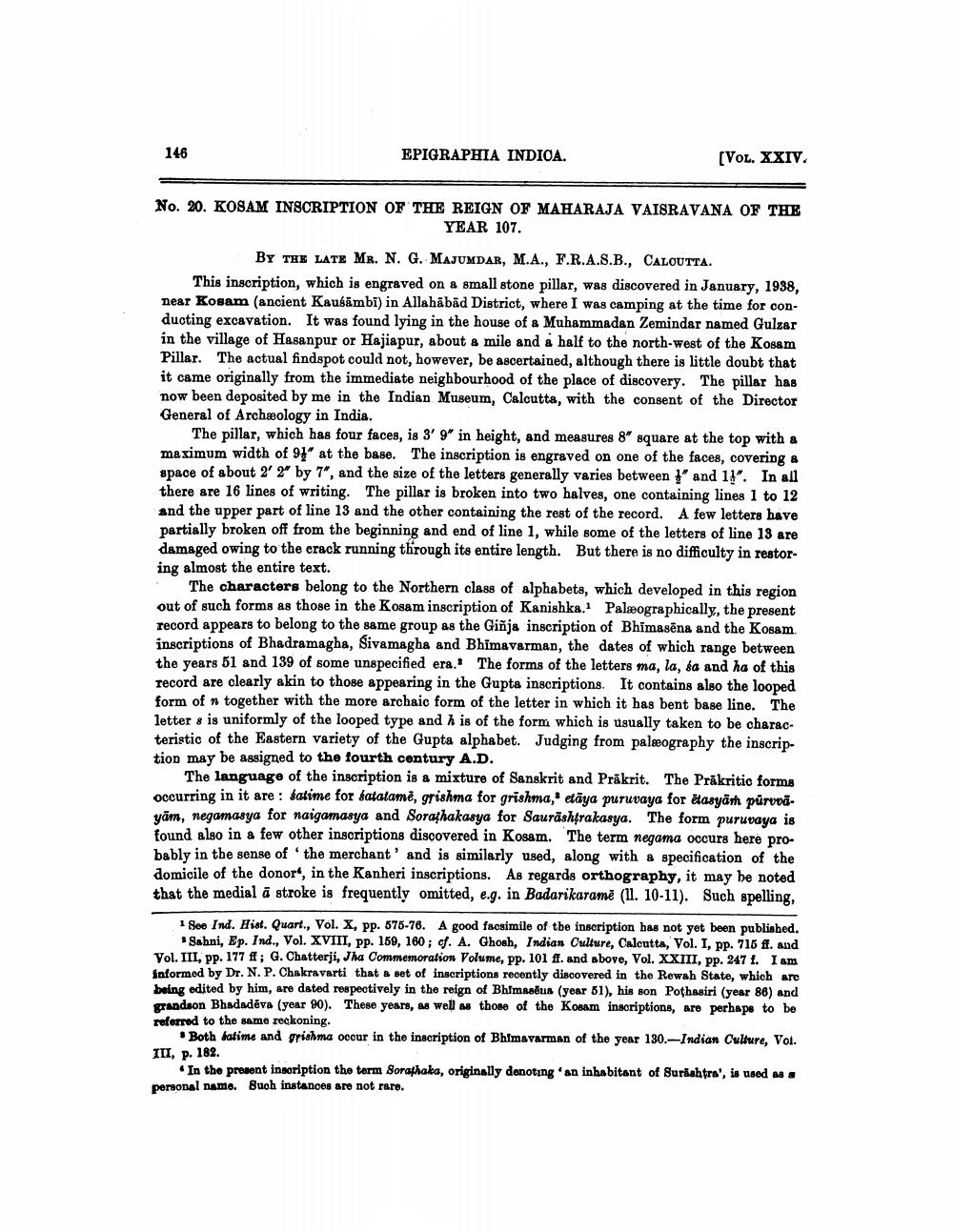________________
146
EPIGRAPHIA INDICA.
(VOL. XXIV.
No. 20. KOSAM INSCRIPTION OF THE REIGN OF MAHARAJA VAISRAVANA OF THE
YEAR 107.
BY THE LATE MR. N. G. MAJUMDAR, M.A., F.R.A.S.B., CALOUTTA. This inscription, which is engraved on a small stone pillar, was discovered in January, 1938, near Kosam (ancient Kausambi) in Allahābād District, where I was camping at the time for conduoting excavation. It was found lying in the house of a Muhammadan Zemindar named Gulzar in the village of Hasanpur or Hajiapur, about & mile and a half to the north-west of the Kosam Pillar. The actual findspot could not, however, be ascertained, although there is little doubt that it came originally from the immediate neighbourhood of the place of discovery. The pillar has now been deposited by me in the Indian Museum, Calcutta, with the consent of the Director General of Archæology in India.
The pillar, which has four faces, is 3' 9" in height, and measures 8" square at the top with a maximum width of 91" at the base. The inscription is engraved on one of the faces, covering & space of about 2' 2" by 7", and the size of the letters generally varies between 1 and 1!". In all there are 16 lines of writing. The pillar is broken into two halves, one containing lines 1 to 12 and the upper part of line 13 and the other containing the rest of the record. A few letters have partially broken off from the beginning and end of line 1, while some of the letters of line 13 are damaged owing to the crack running through its entire length. But there is no difficulty in restoring almost the entire text.
The characters belong to the Northern class of alphabets, which developed in this region out of such forms as those in the Kosam inscription of Kanishka. Palæographically, the present record appears to belong to the same group as the Giñja inscription of Bhimasēna and the Kosam. inscriptions of Bhadramagha, Sivamagha and Bhimavarman, the dates of which range between the years 51 and 139 of some unspecified era. The forms of the letters ma, la, sa and ha of this Tecord are clearly akin to those appearing in the Gupta inscriptions. It contains also the looped form of n together with the more archaic form of the letter in which it has bent base line. The letter & is uniformly of the looped type and h is of the form which is usually taken to be characteristic of the Eastern variety of the Gupta alphabet. Judging from paleography the inscription may be assigned to the fourth contury A.D.
The language of the inscription is a mixture of Sanskrit and Präkrit. The Präkritic forms occurring in it are : fatime for katatamē, grishma for grishma, etāya puruvaya for easyäth puruvā yām, negamasya for naigamasya and Sorathakasya for Saurashtrakasya. The form puruvaya is found also in a few other inscriptions discovered in Kosam. The term negama occurs here probably in the sense of the merchant' and is similarly used, along with a specification of the domicile of the donor', in the Kanheri inscriptions. As regards orthography, it may be noted that the medial a stroke is frequently omitted, e.g. in Badarikarame (ll. 10-11). Such spelling,
See Ind. Hist. Quart., Vol. X, pp. 575-76. A good facsimile of the inscription has not yet been published.
Sahni, Ep. Ind., Vol. XVIII, pp. 159, 160; df. A. Ghosh, Indian Culture, Calcutta, Vol. I, pp. 715 ff. and Vol. III, pp. 177 ff; G. Chatterji, Jha Commemoration Volume, pp. 101 ff. and above, Vol. XXIII, pp. 247 f. I am informed by Dr. N. P. Chakravarti that a set of inscriptions recently discovered in the Rewah State, which are being edited by him, are dated respectively in the reign of Bhimasēta (year 51), his son Pothasiri (year 86) and grandson Bhadadēva (year 90). These years, as well as those of the Kosam inscriptions, are perhaps to be referred to the same reckoning.
Both fatime and prishma ooour in the inscription of Bhimavarman of the year 130.- Indian Culture, Vol. III, p. 182.
In the present insoription the term Soraphaka, originally denoting an inhabitant of Suriahtra', is used as personal namo. Such instances are not rare.




